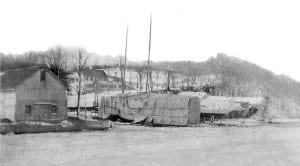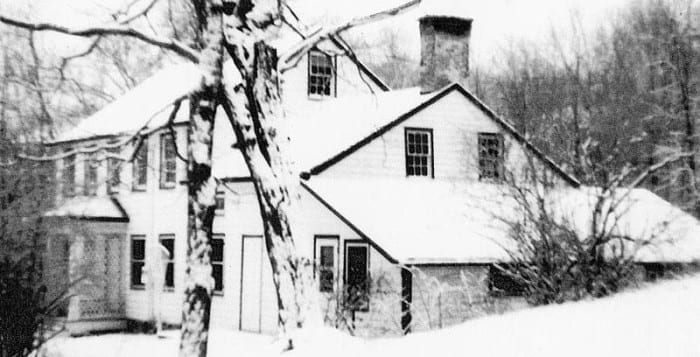“Silent but smiling, Henry hit William again and again, leaving the young man lying senseless on the carpeted floor.”
It’s a story that unfolds like a dark novel. A member of a prominent family in a quiet, seaside village snaps one day and beats his relatives to death at the home they shared, splattering blood everywhere, before hanging himself in the backyard barn. A child who narrowly escapes the massacre grows up to be a successful businessman but will remain forever haunted by his memories.
The 1857 murder-suicide on Beach Street shocked the Port Jefferson community and would likely still shock residents today.
It could have all started with the reportedly turbulent relationship between Henry Walters and his wife of three years, Elizabeth Darling-Walters. Or perhaps it was the feud between Walters and his wife’s son-in-law William Sturtevant that was boiling into legal action despite the two living under the same roof.
According to a narrative written by former Port Jefferson historian Ken Brady and published in the Port Times Record 10 years ago, the gossip around the village was that Walters, 57, and Darling-Walters, 46, fought frequently, with things so bad that they did not share a bed. The husband, a carpenter and a farmer, felt ignored and was “worried that his wife would leave her substantial estate to Martha Jane and Emmet,” her children from her first marriage to the late Matthew Darling, one of the founders of the nearby Darling Shipyard on the west side of the harbor.
The Darling family was originally from Smithtown but built their Port Jefferson shipyard in 1832 and quickly became prolific, building 13 ships during that decade alone.

If the chatter is true, Walters showed warning signs of a violent outburst. Brady wrote, “In a creepy attempt to win back his wife’s affections, Henry bought a shroud from local coffin maker Ambrose King. Walters often wore the white burial sheet about the homestead, threatening to commit suicide if Elizabeth did not return his love.”
At the same time, the farmer’s feud with Sturtevant and his father, fellow ship carpenter Amasa Sturtevant, who also lived on Beach Street, had reached a climax the day before the son-in-law’s murder — according to Brady, Walters received a letter from William Sturtevant’s attorney, Thomas Strong, warning him to “retract statements he had made about young Sturtevant” by Nov. 21, the day of the bloodshed, “or to expect a slander suit.”
That Saturday morning in the white, one-and-a-half-story home, Darling-Walters was eating breakfast with the young Sturtevant couple when Walters, finished feeding the horses, grabbed an iron bar and rushed into the dining room. According to Brady, the son-in-law was bludgeoned to death first with blows to the head, “splattering brain matter on the walls and furniture.” Then Walters went after his wife and 20-year-old stepdaughter, who both fled outside.
“Elizabeth tried to shield herself from the savage blows, but soon fell to the ground mortally wounded, her skull fractured and dress soaked with blood.”
Martha Jane Sturtevant was spared when Matthew Darling’s younger brother, Beach Street resident John E. Darling, heard his seriously injured niece’s screams. Brady said when Walters caught sight of the man, he went back inside and looked for 11-year-old Emmet Brewster Darling. But the boy was hiding under a bed in the attic and, while his stepfather was in another room, ran down the stairs and escaped Walters’ pursuit.
“Her barn was haunted by the ghost of Henry Walters, whose terrifying screams supposedly echoed over the harbor.”
That’s when Walters went into the barn, put a white handkerchief over his face and hanged himself. According to Brady, the murderer had neatly folded his coat and vest and placed them on a bench.
Despite his traumatic experience, Emmet Darling, who also went by E.B. Darling and whose first name has sometimes been misspelled as “Emmett,” grew into a productive adult. According to former Cedar Hill Cemetery historian George Moraitis, Darling took over his family’s shipyard and married twice before his death almost 30 years after the murders.
His elder sister moved on to a degree — in his written history “Forevermore on Cedar Hill,” Moraitis noted that Martha Jane later remarried, to Capt. Oliver Davis. But Brady said the woman lived in the same house where her mother and first husband were murdered until her own death in 1906, “despite claims from some villagers that her barn was haunted by the ghost of Henry Walters, whose terrifying screams supposedly echoed over the harbor.”
No one else will live in the murder house, however — both the home and the shipyard property have been torn down and rebuilt. The Port Jefferson Village historical photo archive notes that the Port Jefferson Fire Department burned down the home during a drill 60 years ago, on Jan. 22, 1956, and a Suffolk County sewer facility took its place. The Darling shipyard, on the other hand, eventually became a power plant.
Darling-Walters is buried at Cedar Hill with her first husband and daughter, and William Sturtevant at his own family’s grave site there. Emmet Darling rests at Oak Hill Cemetery in Stony Brook with his second wife, Julia A. Oakes.
According to Moraitis, the killer’s burial place is unknown.





